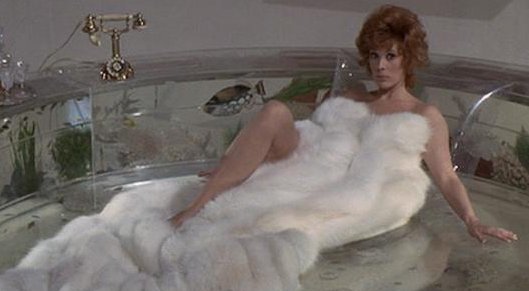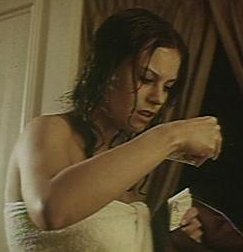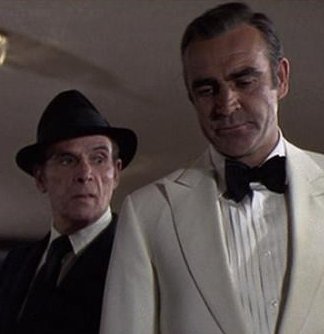The picture isn't bad; it's merely tired,
and it's often noisy when it means to be exciting ....
- Pauline Kael in The New Yorker (January 1972)
Diamonds Are Forever
Film: 1971 (#7)
Book: 1956 (#4)
Bond kills Blofeld. No, really, this time for sure! Now he can do some "plain, solid work," which means impersonating a diamond smuggler and ending up in Las Vegas getting tangled in the schemes of a diabolical mastermind in gray with a white cat who is impersonating a reclusive millionaire in order to facilitate his scheme to build a gigantic diamond-encrusted space laser. Honest. I can't make this stuff up.
Book vs. Film
Fleming's fourth novel was a bit of an intermission; its scope is small, and Bond is workmanlike rather than adventurous throughout. Strictly business. Smersh is not involved in any way (and SPECTRE/Blofeld didn't even exist yet). The major antagonist is the Spangled Mob, named for the brothers Spang who run it. Bond has been assigned to infiltrate a diamond-smuggling pipeline and trace it to its leader. The action takes him first to the Saratoga racetrack in America, where he runs into Felix Leiter - now working for Pinkerton's, because Fleming was aware the CIA can't operate domestically, even if some Bond screenwriters were not. Eventually he ends up in Las Vegas, and finally in Sierra Leone, the source of the diamonds. Along the way he tangles with some characters whose names are kept in the film - Shady Tree, a link in the pipeline in New York; Tiffany Case, who hates men because she was gang-raped as a teenager; and killers Wint and Kidd, who are overtly homosexual in the book as opposed to wink-and-sneer homosexual in the film. Apart from the names of those characters, the Las Vegas location, and the diamond pipeline, nothing from the book was kept for the film.
Himself
Pretty good. It's not his fault the script apparently decided that the only way the audience would take an older Connery seriously is if they lapsed halfway into camp. Connery decided the best way to play this material was with a poker face, and he mostly pulls it off. The film has many faults, but he's not one of them. Also, say what you will about the man's physique at the time, but no one plays Bond if they're in truly horrible shape (they wouldn't survive it), and the film's nastiest fight - with Peter Franks in the elevator - is thoroughly believable.
[Actually, I have a confession to make: I (visually) prefer Connery with more weight on his face. It makes him look less ratlike. The hairpiece is unfortunate, though.]
Docked ten style points for wearing white formal evening wear in a 1970's US casino - wish they'd kept in the scene with Sammy Davis Jr. making fun of it. Awarded ten million style points for stepping blithely out of his hotel window to catch an elevator - the top of the elevator - and adjusting his boutonniere on the way up.
The Women
Tiffany Case, despite Fleming's strange habits writing "damaged" women (his stigma, not mine), is one of his stronger female characters. She is written as being capable under a hard protective shell, but secretly lonely and insecure. Fleming apparently liked her enough that he added several chapters to the end of the book depicting Bond's downtime with her on the Queen Elizabeth, with Bond going so far as to contemplate marriage. She is a stronger Fleming character than either Vesper Lynd or Pussy Galore; not as strong as Gala Brand, whom you will likely not have heard of (see Moonraker). The differences between the characters in the books and their onscreen portrayals can sometimes be attributed to the script, but in this case I tend to blame the actress.
Basically, I'm just not impressed with Jill St. John. She has her moments, but unlike Honor Blackman, she doesn't look uncomfortable when the plot forces her to lapse into bimbo mode; in fact she tends to convey that this is her normal state and the parts when she was clever and capable were aberrations. Short answer is, Tiffany is great in her first scene and goes downhill from that for the rest of the film. At various places she might as well be Plenty O'Toole, the part she was originally offered.

"I'm cooperating, Mr. Leiter, really I am."
Strangely, there is little to complain about in Bond's approach to either woman. With Plenty, they both know the nature of the relationship and have no illusions about it (despite the cheesy cover banter); with Tiffany, he is only condescending to her when, frankly, the character has richly earned it. Or at least that's how I recall it. It's possible I could be biased, because of how disappointed I am in St. John.
Backstory
This is the last Bond film to overtly use either Blofeld or (by implication) SPECTRE. Kevin McClory had begun making noises about those being his intellectual property (see Thunderball), and EON decided to just steer clear.
Originally, EON's idea was that the only way to reverse the slump of the previous two films was to make another Goldfinger. I mean that in a very literal sense. In addition to bringing back director Guy Hamilton, Ken Adam, and Richard Maibaum, Maibaum's script was actually a direct sequel, featuring Goldfinger's twin brother, intent on revenge (who would be played by Gert Fröbe). This lasted until UA head David Picker intervened in the process in two direct ways.
A Bond recasting hunt had begun by EON (including reportedly considering Michael Gambon, who declined because he felt he was not in good enough physical shape), and they had settled on American actor John Gavin. (One wonders whether an American Bond would have worked.) Picker was intent that Connery be rehired at any cost, and went out to convince him in person. "Any cost" turned out to be 1.25 million dollars (some sources say pounds), plus bonuses for every day shooting went over schedule, plus 12.5% of the gross, plus UA funding any two films of Connery's choosing. (He used his first free pass on The Offence; the second never got made. He donated his entire base fee to provide the major chunk of initial funding for the Scottish International Educational Trust.) Gavin was compensated with $50,000.
Picker's second intervention was to bring in Tom Mankiewicz to redo Maibaum's script as a Blofeld script - throwing out everything but the diamonds, the space laser, the Vegas locations, and Willard Whyte being replaced by an impostor.
As noted above, Jill St. John was originally going to be cast as Plenty O'Toole. Raquel Welch, Jane Fonda, and Faye Dunaway were all reportedly considered before St. John was bumped up (and Lana Wood, Natalie's little sister, was given Plenty). Charles Gray was tapped as the best of the three visible Blofelds (although that might not be saying much).
This film did indeed reverse the slide - how much of it was due to Connery is open to debate - making more money than any previous or future Bond until Goldeneye.
The Briefing
I can see why they didn't want to film the book, which is very low-key and actually a little dull, but I could wish they had come up with a less shaky substitute plot. Putting aside any suspension of disbelief about how an apparently unrelated diamond-smuggling case nonetheless manages to connect back to the man with the cat, for me this is the first Bond film where I have serious issues with plot holes and similar insanity. (Sadly, it will not be the last.)
For example, I don't know why Wint and Kidd seal Bond in a pipe instead of just killing him; I don't know what good putting diamonds on the outside of a space laser would do anyone; I don't understand why Blofeld doesn't try to kill Bond in his office instead of passively letting him get gassed in the elevator - or, for that matter, why Bond doesn't make a second attempt to kill Blofeld in the office after picking the "wrong pussy." I mean, this is the man we saw in the pre-credits sequence actively making life hell for anything that stood between him and his vendetta. No one actually told the real Bert Saxby to go out and kill Willard Whyte, unless we assume that Blofeld caught on somehow that the phone call was a fake; Bond's logic about why they haven't paid him off with real money is a bit spurious; I dislike the way the film keeps producing fake Blofelds; and the moon-buggy sequence is just completely unnecessary in every respect, including test astronauts moving in slow-motion while they are operating under Earth gravity.
If you can get past all that, this is a decent film marred by a cheap sense of humor, the self-parody elements, and some bad characters - Wint and Kidd are so badly played that one forgets they're supposed to be the scariest characters in the film; Jill St. John, as already noted, is a mess; Felix Leiter is barely given bumbling-sidekick status (and as noted above, his activities in this film are illegal); and Blofeld is, as usual, not nearly intimidating enough.
In this film, Bond enters the Seventies (after having largely skipped the more interesting bits of the Sixties). The Cold War is gone; from here on, the "game with the Russians" will be played mostly as a joke, if at all. SPECTRE is gone and will never return; from now on diabolical masterminds will be acting purely on their own. The atrocities of Seventies fashion are beginning to make themselves known (later to be replaced with the atrocities of Eighties fashion). Blackmail is still a workable diabolical plot, but the films have to get increasingly schizophrenic to justify British involvement ("Your pitiful little island hasn't even been threatened").
If I have a problem during rewatches of this film it's that I think Richard Maibaum was correct when he complained his original ending had been changed to "an interminable thing on an oil rig." Since I also am unimpressed with the "bombe surprise" sequence (and unimpressed with the henchmen being killed off after the main villain, which I regard as a Bond Demerit), I tend to just turn it off after Jimmy Dean drawls "I haven't got anything in Baja."
Incidentally, Dean, basically a non-actor, does an excellent job for the five minutes he's in the film, making me wish they'd written him a much bigger part.
Obscura
Despite all sorts of American location shooting, including the moon-buggy sequences in the Nevada desert, the actual Circus Circus casino, and an actual oil rig, the Vegas street chase was not done on location - it was done on a backlot at Universal Studios (possibly the first time a Bond film had done soundstage/backlot work anywhere but Pinewood).
Lois Maxwell almost didn't do this film. She felt the low pay didn't justify having to grind her other work to a halt for a few days every time a new Bond film rolled in. EON said she'd be replaced if she insisted on a pay raise. She shrugged and dyed her hair black to go audition for a part in Endless Night (which she got). There was an outcry over replacing Moneypenny, and EON came back to her and asked her to do it. According to Maxwell, this is why she's in a police uniform at Dover - so she'd have a reason to wear a hat to cover her black hair. It may also explain why her scene is separate from the M scene.
Speaking of which, the gent who briefs Bond on diamond smuggling, Sir Donald Munger, is played by Laurence Naismith, whom Roger Moore followers will recognize as Judge Fulton on "The Persuaders," which would have been airing about this time.
While I am willing to believe Bond is fairly expert at wines (although it doesn't take an expert to know that Mouton Rothschild is a claret, or what everyone but the British calls a Bordeaux), I simply do not believe that Bond is the sort of expert sherry taster needed to be able to identify the base vintage of a solera. That's the sort of thing you devote a lifetime to doing. (Of course, Bond appears to have more than one lifetime ....)
Willard Whyte is based on Howard Hughes, who was a friend of Broccoli's and gave EON extensive access to his properties for filming, in exchange for one print of the film. Jimmy Dean, who indirectly worked for Hughes (performing in his casino), was reportedly worried about taking the role for fear of offending his boss.
Some people have tried to handwave the "moon" sequence by saying it is a reference to the theory that the moon landings were faked (e.g. that Blofeld is filming fake moon-landing footage). Certainly the '71-'72 Apollo missions did use a "moon buggy," although it didn't look like the one in the film. I prefer to believe that the astronauts-in-needless-slow-motion is just the filmmakers screwing up.
This film was cut extensively for time (some people believed the long running time had hurt OHMSS). Some of the cut scenes, like the Sammy Davis Jr. scene, are fun but not vital, but some of them actually affect continuity. During the Glitter Gulch sequence, where Bond drives the car through the narrow alley on two wheels, it's true that he does emerge from the alley on the wrong pair of wheels, but this is because of a cut; as originally shot, he goes back through the alley a second time.
The inexplicable appearance of Plenty O'Toole in Tiffany's pool is explained by a cut sequence where Plenty, returning to Bond's hotel room dripping wet and angry at being turfed out, steals Tiffany's address and presumably goes to her house to confront her.

She tries on one of Tiffany's wigs, and Wint and Kidd kill her by mistake. (Of course, this is marred slightly by the fact that they know what Tiffany looks like, having seen her on the plane.)
Minor casting watch: David De Keyser, who dubbed Draco in the previous film, is in here somewhere as a doctor. Valerie Perrine makes her film debut here as one of Shady Tree's "acorns." Stalwart Shane Rimmer (don't worry, we'll get a good look at him eventually) is in here somewhere.
The gangster who throws Plenty out the window and gets one of the best lines in the film is Marc Lawrence, who will turn up playing almost exactly the same character two movies hence.

"I didn't know there was a pool there."
« Heavy Bondage
« Opening Titles
All material on this site is under copyright by its author, except for quotations and images used for purposes of commentary (and which belong to their respective owners/authors). All rights reserved. Do not reproduce without express permission. Correspondence goes to projectionist at shrunkencinema dot com. No guarantees. Contents may settle during shipping; this product is sold by weight, not by volume.
These pages and their author have absolutely no affiliation whatsoever with Ian Fleming (Glidrose) Publications, EON Productions, Danjaq LLC, MGM/UA or any other creators of the James Bond novels or films.